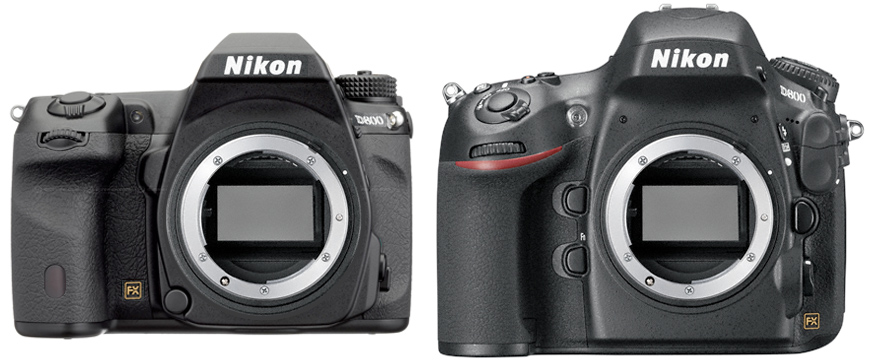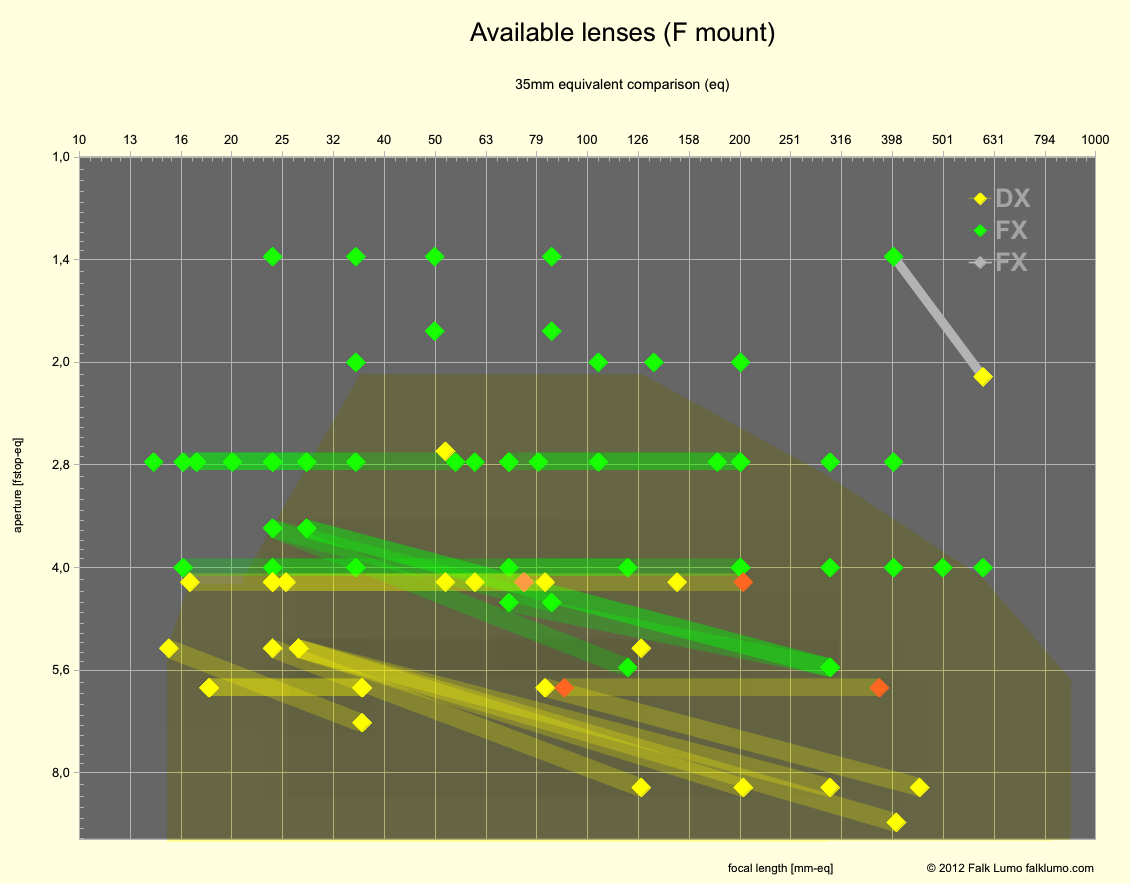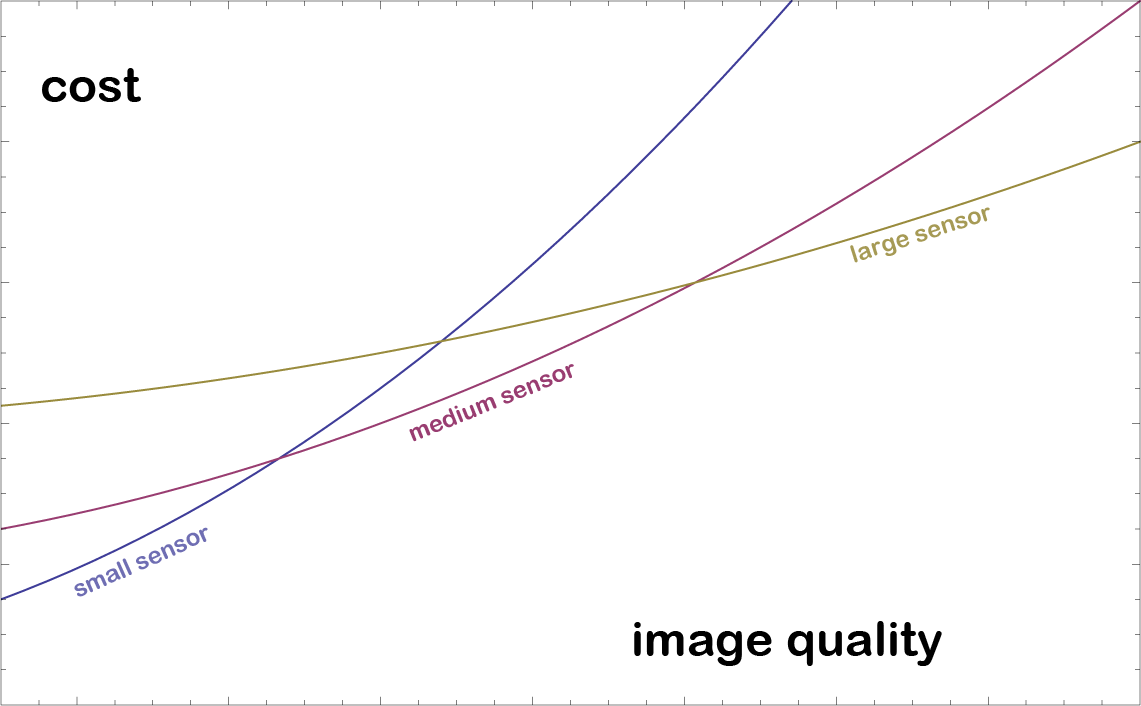and the true reasons for a full frame camera
 |
Nikon D800 (right) and a hypothetical more compact D800c full frame camera (left) built along the design principles of the beautiful Pentax K-5 APS-C SLR. The K-5 is smaller than the D800c depicted above.
-- please click to enlarge -- |
Two years ago, right before the Photokina 2010 trade show, I had a detailed look at a possible trend for full frame cameras:
At that time, full frame was a non issue and until recently, no new full
frame camera was released indeed. Mirrorless system cameras (SLD) were
the new kids on the block. However, I guessed that SLR camera makers, most notably Pentax, better do some serious homework in 2011 and develop a "
24-35 MP full frame SLR with Exmor HD sensor". To be launched
before Photokina 2012.
As it turns out, Nikon (and Canon) did exactly this: the remarkable Nikon D800 now takes the enthusiast market by storm. It was meant to be a 2011 release but it was then postponed due to the natural desasters in Japan. And what remains from the enthusiast market may well become victim of the Nikon D600 which is about to launch right before
Photokina (Cologne, 2012, September 18 - 23). It is rumored to be priced right where the enthusiast market used to be a couple of years ago. OTOH, Pentax was busy to digest a change of ownership (Hoya to Ricoh) which means nothing but that they lost precious time again.
So, what does it all mean for 2012 and the years to come?
Well, before I start to share my guess work, I'd like to clarify why full frame is an interesting technical proposition at all.
The true reasons for a full frame camera
There is an amazing amount of false information floating around the internet when it comes to the benefits of form factors such as 35 mm full frame or APS-C. Typical examples include statements that full frame equals more shallow depth of field, less noise or unreasonably high sensor cost. Or that APS-C is better because it is good enough in a smaller and less expensive package. Unfortunately, such statements are too simple to be possibly true.
Full frame basically offers more choice or options which may or may not lead to better image quality or other benefits. It is necessary to look at each aspect in somewhat more detail. Therefore, I compiled a LumoLabs white paper listing the true reasons in favour of a full frame or APS-C camera:
 |
Available interchangeable lens options (in 35-mm equivalent terms) for cameras with 35-mm or APS-C sensor, resp. Shown with an emphasis on Nikon. Fig. from the white paper "The true reasons for a full frame camera".
-- please click to enlarge -- |
In a nutshell and citing the paper's conclusion, full frame cameras, esp. full frame digital SLRs, are a good option to obtain premium image quality. I explained why there is a sweet spot of
image quality where full frame cameras deliver the most cost-efficient
solution today. And this is why their market impact must be increasing
rapidly.
 |
Cost vs. performance for various sensor formats. Fig. from the white paper "The true reasons for a full frame
camera".
-- please click to enlarge -- |
I believe that the region where a 35 mm full frame sensor is the sweet spot may be expressed today as the region of images with between 20 and 50
clear mega pixels. At lower resolution requirements, I think APS-C still provides the better alternative
and above it may be medium format. The Nikon D800 sits right in the
middle of this region and this may explain why it is such a smash hit.
Moreover, I think that the region of
premium image quality will remain the domain of SLRs for quite a while.
Because lenses aren't that small anyway and the optical viewfinders are
harder to beat (they are hard to beat anyway when it comes to low light
and fast action). This means that every SLR maker will ultimately have
to offer a compelling range of full frame cameras and lenses (in order
to stay SLR maker).
Statements derived from the above white paper I am going to use here include:
- There is a level of maximum image quality where full frame offers no benefit over APS-C. At that level, images from full frame and APS-C cameras are basically indistinguishable. And at that level, the weight and price difference between both types of cameras is small (technically speaking).
- There is a level of image quality which corresponds to printout sizes of approx. DIN A2 or 16" x 24" where full frame cameras (today) offer the better price/performance ratio (technically speaking) or the only option (practically speaking).
- There are some niche applications (single image HDR, very low available light, fast and accurate focus, portrait/very shallow depth of field) where full frame cameras are clearly better.
- There are (fewer) niche applications (sports) where an APS-C or a low pixel count (or a fast crop mode) full frame camera still is a better choice.
I confine my consideration to APS-C vs. full frame. The reason is simple: other formats don't share the same mount. And larger or smaller formats currently slightly lack in terms of implementation. E.g., you may look at the current score board leaders at
dxomark.com , using tscore = dxoscore + 30 x log_2(crop-factor) as format-independend technology index (the DxO score increases by 15 per EV stop of performance):
- Medium format (Phase One IQ180, Pentax 645D): tscore = 72
- Full Frame (Nikon D800E): tscore = 96
- APS-C (Pentax K-5): tscore = 100
- FourThirds (Panasonic Lumix DMC GH2): tscore = 90
Therefore, APS-C and full frame cameras perform almost equal when using equivalent lenses (with a possible difference in effective resolution). Other formats (or Canon) currently perform a bit lesser, when compared to cameras equipped with the Sony Exmor column-parallel ADC sensors.
Photokina 2012 and the full frame mystery
By "full frame mystery" I describe the fact that the APS-C dSLR was originally introduced (in 1998/DCS520 $12,000) as a
temporary technical compromise in order to make a digital SLR feasible at all. And 35 mm full frame was introduced when that was feasible then (in 2000/Contax-ND $6,500, and Photokina 2002/Canon-1Ds $8,000/Kodak-14n $4,000).
But for no known reason, the market separation between entry-level SLR (APS-C) and pro-level SLR (full frame) has become a non-moving barrier. Around 2008 (3 years after the 5D) it should have reached and moved out of the $1,500 enthusiast camera segment. As described in the white paper above, there are no good technical reasons to explain why it did not happen. Including the manufacturing price differences which faded away, compared to what they have been initially. Today, the manufacturing price difference shouldn't be more than a few hundred $ (own research, would be the topic of a different blog article).
I assume two reasons which are responsible for this mysterious phenomenon:
- Market separation: Spreading information (sometimes misleading, esp. from Canon), how expensive it would be to make a full frame sensor, vendors have been able to sell cheap APS-C cameras w/o cannibalizing their revenue from expensive pro gear. Customers trusting such statements never "asked" for more, or accepted a premium price for full frame.
- The differences between APS-C and full frame (other than missing equivalent lens options) may not have been significant between about 10 and 20 MP. Therefore, the "good enough" argument applies to some extent.
Therefore, I claim (and actually already claimed in my 2010 article) that by 2012 there is an artificial separation between the APS-C and full frame markets. Artificial because less people still believe that full frame must be expensive. And artificial because image qualities beyond an effective resolution of 20 MP may simply require full frame. The new offers from Nikon (D800 and D600) therefore directly address this and may accelerate the disappearence of the artificial market separation. This is known as "supercriticality": the market ought to offer uncrippled, full frame enthusiast cameras in the $1,500 segment but offers APS-C cameras instead. Supercritical systems "fall" into their preferred state after only small perturbations occur. Once this happens, a D800 type camera will be in the $1,500 segment.
I believe we're going to see things unfold now:
While Photokina 2010 was dominated by the event of mirrorless (SLD) cameras, Photokina 2012 may start a trend for dSLRs to be full frame (only). This assumes that the entry level below $1,000 can't be defended by APS-C SLRs: the competition from SLDs (1" to APS-C) and large sensor compacts (1" etc.) may become too intense and the accuracy problems of APS-C phase-AF beyond 20 MP may start to become a problem.
On the other hand, I don't expect SLRs to disappear any time soon. A good optical viewfinder is almost impossible to beat in the next couple of years and hybrid viewfinders may bring some of the benefits of SLDs to SLRs.
Therefore, I speculate that four things are going to happen until Photokina 2014:
- Full frame SLRs become mainstream above $1,000, in a more compact form factor.
- Hybrid viewfinders combine the best of two worlds in high end SLRs.
- Mirrorless SLDs and large sensor compact cameras dominate the segment between $500 and $1,000, mobile phones below.
- Full frame SLDs emerge.
Of course, this means that the cameras with a full frame mount but a half frame sensor become what they meant to be: a curiosity of the past. The full frame mystery will eventually be obsolete. Let's check back before Photokina 2014 ;)
And Pentax ? ... ;)
Long time followers of my blog know that I have quite some sympathy for Pentax. Pentax, 10x smaller than Nikon or Canon but with products challenging the most popular cameras of the big two. E.g., I consider the Pentax K-5 to be a better camera than the Nikon D7000: similiar, but more beautiful, more ergonomic and more fun to use. This is why I would be very disappointed to see Pentax and their K mount continue to fade away as it did in the past since the arrival of the K10D.
Pentax, now having lost half of their enthusiast user base, cannot wait until Photokina 2014 to join what then will be the full frame SLR bandwagon. Their remaining enthusiast users can't wait: the jump in image quality from, say a K-5 to say, a D800 is too dramatic to be ignored. I cannot imagine that Ricoh has bold plans for the K mount but then doesn't come to the same conclusion. Therefore, I assume Pentax to at least "leak" information around Photokina 2012 wrt their own plans. Speculation goes they release a full frame SLR with the Sony A99 sensor in 2013. They better do. The K mount has no future as APS-C only. Esp. as the mirrorless K mount bodies (K-0x) make much more sense with full frame.
CU @ PK12 :)





